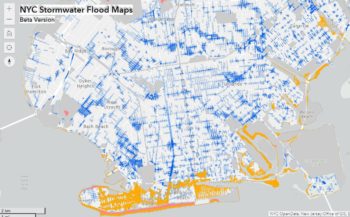
Image from the stormwater flood map depicting effects in an extreme flooding scenario of combined rising sea levels and severe rainfall. Image Credit: NYC Mayor’s Office of Resiliency
Climate change is projected to have a dramatic effect on rainfall in New York City through 2100; the new plan provides projections for being prepared for these changes. On May 14, 2021, Mayor de Blasio released New York City’s Stormwater Resiliency Plan. The plan provides the City’s first city-wide flood analysis caused by rain which can cause flooding in any part of the city.
The New York City Panel on Climate Change projected that the City will have increased rainfall as global warming continues to worsen. Projections show about a 25 percent increase in rainfall by the end of the century. This increase could put a strain on the City’s drainage infrastructure of sewer systems, Bluebelts, and green infrastructure assets.
The Plan outlines goals and initiatives for the City to implement over the next ten years. This includes policies for stormwater management, future looking climate change projections, flash flood emergency response procedure changes, and more focus on communications related to rain-based flooding.
The Plan is supported by years of various analysis. The City partnered with various institutions to model flooding from extreme rain and climate events. The model was enhanced to include considerations on City assets like localized sewer network capacity, overland drainage pathways, tidal conditions, sea level, and rainfall intensity.
The analysis that was done has led to the creation of maps showing areas vulnerable to flooding from rainfall and climate conditions. These maps can be accessed here. The maps build on the NYC Flood Hazard Mapper tool from 2017. This tool shows coastal hazards and in the coming years will integrate with the new maps and conduct additional modeling to understand complex and simultaneous interactions of storms, sea levels, and rainfall. These maps will not have any impact on flood insurance rates.
Mayor Bill de Blasio stated, “A Recovery for All of Us requires protecting all New Yorkers from the threat of climate change and severe storms. The new Stormwater Resiliency Plan will be a critical to keeping our residents safe and creating a more resilient city.”
Director of the Mayor’s Office of Climate Resiliency Jainey Bavishi stated, “The Stormwater Resiliency Plan analyses how future extreme rainfall events could impact the five boroughs and outlines the steps the City is taking to reduce risks using green infrastructure, land use changes, long-term drainage improvements, improved evacuation plans, and more. With climate change projected to cause more rainfall in New York City, this plan will continue to increase our resiliency and protect New Yorkers from emerging threats.”
Department of Environmental Protection Commissioner Vincent Sapienza stated, “Centuries of environmental neglect have caused our climate to change and in order to continue to adapt to this new reality we must first understand our vulnerabilities. The City has made major capital improvements in drainage infrastructure during the past seven years and the Stormwater Resiliency Plan will support those ongoing investments to protect residents across all five boroughs.”
By: Patrick McNeill (Patrick is the CityLaw intern and a New York Law School student, Class of 2022.)

